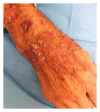Mechanisms of action of topical corticosteroids in psoriasis
- PMID: 23213332
- PMCID: PMC3508578
- DOI: 10.1155/2012/561018
Mechanisms of action of topical corticosteroids in psoriasis
Abstract
Psoriasis is a lifelong, chronic, and immune-mediated systemic disease, which affects approximately 1-3% of the Caucasian population. The different presentations of psoriasis require different approaches to treatment and appropriate prescriptions according to disease severity. The use of topical therapy remains a key component of the management of almost all psoriasis patients, and while mild disease is commonly treated only with topical agents, the use of topical therapy as adjuvant therapy in moderate-to-severe disease may also be helpful. This paper focuses on the cutaneous mechanisms of action of corticosteroids and on the currently available topical treatments, taking into account adverse effects, bioavailability, new combination treatments, and strategies to improve the safety of corticosteroids. It is established that the treatment choice should be tailored to match the individual patient's needs and his/her expectations, prescribing to each patient the most suitable vehicle.
Figures





Similar articles
-
Efficacy and safety of treatment modalities for psoriasis.Cutis. 1998 Feb;61(2 Suppl):11-21. Cutis. 1998. PMID: 9787987 Review.
-
[Topical corticosteroids and corticosteroid sparing therapy in psoriasis management].Acta Med Croatica. 2007 Sep;61(4):375-81. Acta Med Croatica. 2007. PMID: 18044472 Review. Croatian.
-
Factors impacting the combination of topical corticosteroid therapies for psoriasis: perspectives from the International Psoriasis Council.J Eur Acad Dermatol Venereol. 2011 Oct;25(10):1130-9. doi: 10.1111/j.1468-3083.2011.04113.x. Epub 2011 May 13. J Eur Acad Dermatol Venereol. 2011. PMID: 21564329 Review.
-
Management of scalp psoriasis: guidelines for corticosteroid use in combination treatment.Drugs. 2001;61(11):1593-8. doi: 10.2165/00003495-200161110-00006. Drugs. 2001. PMID: 11577796 Review.
-
Psoriasis of the scalp. Diagnosis and management.Am J Clin Dermatol. 2001;2(3):159-65. doi: 10.2165/00128071-200102030-00005. Am J Clin Dermatol. 2001. PMID: 11705093 Review.
Cited by
-
Nanostructured Non-Ionic Surfactant Carrier-Based Gel for Topical Delivery of Desoximetasone.Int J Mol Sci. 2021 Feb 3;22(4):1535. doi: 10.3390/ijms22041535. Int J Mol Sci. 2021. PMID: 33546426 Free PMC article.
-
Intradermal Injection of a Thermoresponsive Polymeric Dexamethasone Prodrug (ProGel-Dex) Ameliorate Dermatitis in an Imiquimod (IMQ)-Induced Psoriasis-like Mouse Model.Mol Pharm. 2024 Oct 7;21(10):4995-5004. doi: 10.1021/acs.molpharmaceut.4c00360. Epub 2024 Sep 3. Mol Pharm. 2024. PMID: 39224912
-
Biochanin A Ameliorates Imiquimod-Induced Psoriasis-Like Skin Inflammation in Mice by Modulating the NF-κB and MAPK Signaling Pathways.Inflammation. 2025 Jun;48(3):1125-1142. doi: 10.1007/s10753-024-02103-5. Epub 2024 Jul 17. Inflammation. 2025. PMID: 39017810
-
Calcipotriol/betamethasone dipropionate aerosol foam for the treatment of psoriasis vulgaris: case series and review of the literature.Clin Cosmet Investig Dermatol. 2018 Oct 9;11:451-459. doi: 10.2147/CCID.S180698. eCollection 2018. Clin Cosmet Investig Dermatol. 2018. PMID: 30349342 Free PMC article.
-
Glucocorticoids and Glucocorticoid-Induced-Leucine-Zipper (GILZ) in Psoriasis.Front Immunol. 2019 Sep 13;10:2220. doi: 10.3389/fimmu.2019.02220. eCollection 2019. Front Immunol. 2019. PMID: 31572404 Free PMC article. Review.
References
-
- Saraceno R, Gramiccia T, Frascione P, Chimenti S. Calcipotriene/betamethasone in the treatment of psoriasis: a review article. Expert Opinion on Pharmacotherapy. 2009;10(14):2357–2365. - PubMed
-
- Lowes MA, Bowcock AM, Krueger JG. Pathogenesis and therapy of psoriasis. Nature. 2007;445(7130):866–873. - PubMed
-
- Laws PM, Young HS. Topical treatment of psoriasis. Expert Opinion on Pharmacotherapy. 2010;11(12):1999–2009. - PubMed
-
- Henseler T, Christophers E. Psoriasis of early and late onset: characterization of two types of psoriasis vulgaris. Journal of the American Academy of Dermatology. 1985;13(3):450–456. - PubMed
-
- Lebwohl M. Psoriasis. The Lancet. 2003;361(9364):1197–1204. - PubMed
LinkOut - more resources
Full Text Sources
Other Literature Sources

